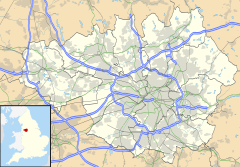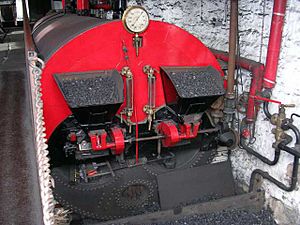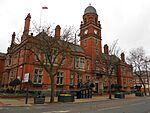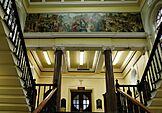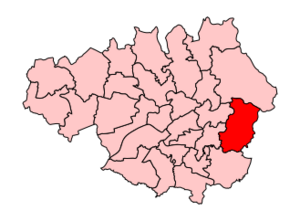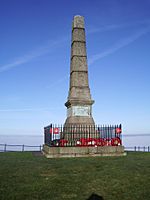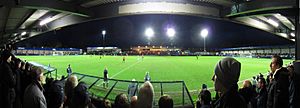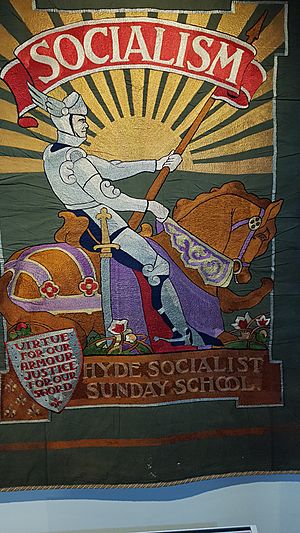Hyde, Greater Manchester facts for kids
Quick facts for kids Hyde |
|
|---|---|
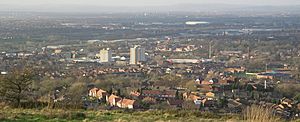 Hyde from Werneth Low |
|
| Population | 35,890 (2021 Census) |
| OS grid reference | SJ945945 |
| Metropolitan borough | |
| Metropolitan county | |
| Region | |
| Country | England |
| Sovereign state | United Kingdom |
| Post town | HYDE |
| Postcode district | SK14 |
| Dialling code | 0161 |
| Police | Greater Manchester |
| Fire | Greater Manchester |
| Ambulance | North West |
| EU Parliament | North West England |
| UK Parliament |
|
Hyde is a town in Tameside, Greater Manchester, England. In 2021, about 35,890 people lived there. It's part of the historic county of Cheshire. Hyde is about 5 miles (8 km) northeast of Stockport and 6.5 miles (10.5 km) east of Manchester.
Contents
History of Hyde
How Hyde Began
In the 1200s, a building called Newton Hall stood here. The area was once a small part of the parish of St Mary, Stockport. The name 'Hyde' comes from an old word, Hide. This was a way to measure land for taxes. It was thought to be enough land to support a farming family. Later, it was seen as about 120 acres (49 hectares).
In the late 1700s, the area that is now Hyde town centre was just a few houses. It was known as Red Pump Street. The area called Gee Cross was much bigger. 'Hyde' mostly referred to the Hyde Hall estates near the River Tame. In 1801, only about 3,500 people lived in the whole district. Hyde really grew into a town in the 1800s, thanks to the Industrial Revolution.
Hyde and the Industrial Revolution
The number of people living in Hyde grew a lot during the Industrial Revolution. This was because of the many cotton mills built in the late 1700s and early 1800s. At one point, there were 40 working mills in Hyde. By 1872, only 27 were left. Most of the remaining mills closed between 1921 and 1939. Today, only one mill still operates in the town.
Many families owned these mills, like the Sidebothams, Hibberts, and Horsfields. The Ashton family were big employers. They ran a successful company that both spun cotton and wove it into fabric. Most mills only did one of these jobs. The Ashton family also built Hyde Chapel in Gee Cross. One of their mills, Ashton Brothers' Mill, was recently taken down to build new homes.
St George's Church was built in 1832. It was the first Church of England building in Hyde. It was started by John Hyde Clarke of Hyde Hall. The church became the main church for part of Hyde in 1842. It has a tall tower, 110 feet (34 metres) high, with eight bells and a clock.
The Peak Forest Canal was built through Hyde. It connected Ashton-under-Lyne to Woodley, Romiley, and Marple. Captain Clarke's Bridge is a well-known bridge over the canal. It was named after Captain Clarke, who lived nearby.
Hyde also had a coal mine called Hyde Colliery. In January 1889, there was an explosion at the mine. Sadly, 23 miners died. A special meeting was held at the town hall to find out what happened. To help the families of the miners, a special football match was played. Ardwick AFC (now Manchester City) played Newton Heath (now Manchester United). This game was played under floodlights and 10,000 people watched. It was the first floodlit match for either team.
How Hyde is Governed
Hyde's Local Government
Hyde became a municipal borough in Cheshire in 1881. This meant it had its own local government. It included the areas of Hyde, Godley, Newton, and part of Compstall. In 1936, the borough grew bigger. It added Hattersley and part of Matley. In 1974, the whole borough became part of Tameside, Greater Manchester.
Hyde Town Hall is a very important building in the town. It stands in the market place. The large bell in its clocktower is called Owd Joss (Old Josh). It was named after Joshua Bradley, who was a poor child worker in the mills. The clock plays the famous Westminster Chimes.
Hyde's Parliament Members
For a long time, the area of Hyde was part of different larger voting areas for Parliament. From 1885 to 1918, Hyde had its own Member of Parliament. Since 1918, Hyde has been part of the Stalybridge and Hyde voting area. The person who represents this area in Parliament today is Jonathan Reynolds.
Geography of Hyde
Werneth Low Country Park is a beautiful place. It is also where the Hyde War Memorial stands. This memorial remembers the 710 people from Hyde who died in the Great War. Local people raised money to build this important memorial.
The River Tame flows through Hyde. This river is a branch of the River Mersey. It separates Hyde from the nearby town of Denton. Hyde has several different areas and suburbs. These include Gee Cross, Newton, Hattersley, Godley, Flowery Field, Kingston, Mottram in Longdendale, Hollingworth, and Broadbottom.
Transport in Hyde
Bus Services
Buses in Hyde are mainly run by Stagecoach Manchester. You can take a bus from Hyde to Manchester city centre, Stockport, Dukinfield, Gee Cross, Woodley, Stalybridge, Ashton-under-Lyne, and Oldham.
Hyde's bus station was first built in the 1960s. It was rebuilt in 2007 and cost £3.7 million. The new station is much larger and enclosed. It was designed to encourage more people to use public transport.
Train Services
There are six train stations in the Hyde area. Trains are operated by Northern Trains.
- Hyde Central and Hyde North stations are on the line between Manchester Piccadilly and Rose Hill Marple.
- Flowery Field, Newton for Hyde, Godley, and Hattersley stations are on the electric line. This line connects Piccadilly, Glossop, and Hadfield.
Roads and Motorways
The M67 motorway serves Hyde. This road connects to the M60, which is a large ring road around Manchester.
Past Tram Services
Hyde used to have a tram network. Trams ran through the town from 1904 to 1945. After that, buses took over the routes.
Media in Hyde
Television and Radio
Local news and TV shows for Hyde come from BBC North West and ITV Granada. You can get TV signals from the Winter Hill TV transmitter.
For radio, you can listen to BBC Radio Manchester (95.1 FM), Capital Manchester and Lancashire (102.0 FM), Heart North West (105.4 FM), and others. There is also Tameside Radio, which is a local community station.
Newspapers
The local newspaper for Hyde is the Tameside Reporter. It comes out every Thursday.
Sports in Hyde
Football
Hyde United F.C. is a football club formed in 1919. They play their home games at Ewen Fields. This ground has also been used by Manchester City and Manchester United for their reserve team matches. From 2010 to 2015, Manchester City's reserve team used Ewen Fields as their home ground. Hyde United had a notable moment in the FA Cup in the 2017–18 season. They reached the first round but lost 4–0 to Milton Keynes Dons FC.
Boxing
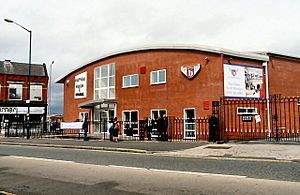
World champion boxer Ricky Hatton grew up near Hyde and now lives in Gee Cross. He is a very famous boxer. He fought against other well-known boxers like Floyd Mayweather Jr. and Manny Pacquiao. Ricky Hatton's boxing career record is 45 wins and 3 losses. At one point, he had won 43 fights in a row! Because of his connection to Hyde, a boxing gym and health club were created there.
Water Polo
The Hyde Seal Swimming & Water Polo Club was very strong in water polo and swimming in England in the early 1900s. They even won the world water polo championship three times!
Cricket
Hyde Cricket and Squash Club plays in the Cheshire County League. Their ground is near Werneth Low. Another club, Flowery Field Cricket Club, is part of the Lancashire County League. A professional cricketer named Len Hopwood was born in Newton, Hyde.
Education in Hyde
Primary Schools
Hyde has several primary schools for younger students:
- St Paul's R.C. School & Nursery: A Catholic primary school, first opened in the early 1900s.
- Bradley Green Community Primary School: Built in 1968.
- Oakfield Primary School
- St George's C.E Primary School: The original building was built in 1836.
- Dowson Primary School
- Godley Community Primary School: Built in 1978.
- Flowery Field Primary School: A new building was built in 2015.
- Leigh Primary School
- Greenfield Primary School: Rebuilt in 1998.
- St James' Catholic Primary School
- Gee Cross Holy Trinity Primary School
Secondary Schools
For older students, Hyde has two secondary schools:
- Alder Community High School
- Hyde High School
Further Education
Colleges for further education, Tameside College and Clarendon Sixth Form College, used to be in Hyde. They have since moved to Ashton-under-Lyne.
Leisure and Fun in Hyde
Hyde Park is the biggest green space in Hyde. It was once part of a private estate. The Ashton family, who owned cotton mills, bought it around 1620. They were one of the largest employers in Hyde. In 1902, Eveline Mary Ashton and Amy Elizabeth Ashton gave the park to the town. It opened to the public on May 21, 1904. The park has a quiet garden, a children's play area, and a rock garden.
Hyde Market has been a place for shopping for hundreds of years. In 1994, the Clarendon Square Shopping Centre opened next to the market. Outside the shopping centre, there is a children's carousel ride. This ride celebrated its 100th birthday on July 6, 2019!
Hyde's Festival Theatre is a place where local groups perform plays, music, and dance. Sometimes, professional shows also visit.
Hyde Leisure Centre has a large swimming pool with a wave machine and a water slide. It also has an upstairs fitness area. This octagon-shaped building opened in the 1990s. It is next to Hyde United F.C.'s football ground.
Hyde also has an Air Cadet Organisation (ACO), called No. 468 (Hyde & Hattersley) Squadron. This group helps young people learn about aviation and develop skills.
Hyde Library used to have a gallery showing the artwork of Harry Rutherford. He was an artist from the Tameside area. His work is now shown in Ashton-under-Lyne.
Famous People from Hyde
Many interesting people were born in Hyde or lived there:
- Luke Baines: An actor, singer, and model.
- John Bramwell: The lead singer of the band I Am Kloot.
- Trevor Grimshaw: A well-known artist.
- Ricky Hatton: A world champion boxer.
- Matthew Hatton: Also a boxer, and Ricky's brother.
- Lee Martin: A former football player for Manchester United.
- Jenny Campbell: A former banker and a panelist on the TV show Dragons' Den.
- Alan West: A footballer who played for Burnley and Luton Town.
Images for kids
-
Ricky Hatton's gym, Hatton Health and Fitness, in Hyde
See also
 In Spanish: Hyde (Gran Mánchester) para niños
In Spanish: Hyde (Gran Mánchester) para niños


